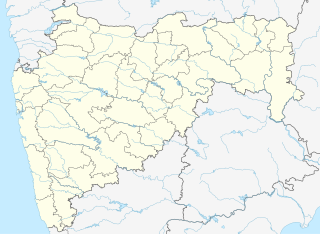Related Research Articles

Budhwar Peth is one of many commercial localities in the old city of Pune, India. The area has a high number of electronics shops, is known for its red-light district and is located in the heart of the city. Three out of the five important ganesh mandals i.e. Jogeshwari Ganpati, Guruji Talim Mandal, Tulshibaug Ganpati are located here, as is Appa Balwant Chowk, known as ABC, which is a crossroads famous for its bookshops and popular with students. The main attraction of Budhwar Peth is Shrimant Dagdusheth Halwai Ganpati.

Tikona also known as Vitandgad) is the dominant hill fort in Maval in western India. It is located near Kamshet around 60 km from Pune. The village nearest to the fort is called Tikona-Peth. The 3500 foot high hill is pyramidal in shape and the name Tikona means "triangular".

Kasba Peth or Kasba is the oldest residential part, "Peth " (locality), in Pune, India. It is adjacent to the historic Shaniwar Wada palace-fort. Kasba Peth was the first Peth to be established sometime during the 5th century, and is the oldest area in Pune. It is called the "Heart of Pune City". In the history of Pune, the city was once known as "Kasbe Pune".
Pune Lok Sabha constituency is one of the 48 Lok Sabha (parliamentary) constituencies in Maharashtra state in western India.
Peth may refer to:
Peth, in the Marathi language, is a general locality in the Indian city of Pune. Up to seventeen peths are located in central Pune, and were mostly established during Maratha and Peshwa rule in the 17th-19th century AD. Seven of them are named after the days of the week in Marathi: traders and craftsmen in a given locality mainly conducted business only on that day of the week.

Shaniwar Peth is a historic ward in the centre of the Indian city of Pune. Shaniwar means Saturday in Marathi and other Indian languages.
Kothrud Vidhan Sabha constituency is one of the 288 Maharashtra Vidhan Sabha (Assembly) constituencies of Maharashtra state in Western India. It is one of the twenty one constituencies of located in the Pune district and one of eight in Pune City.
Kasba Peth Vidhan Sabha constituency is one of the constituencies of Maharashtra Legislative Assembly, in India. This constituency is located in the Pune district and is a segment of Pune.
Pune Cantonment Vidhan Sabha constituency is one of the twenty one constituencies of Maharashtra Vidhan Sabha located in the Pune district and one of eight in Pune City.

Pune City Police Department (PCPD) is the law enforcement agency with jurisdiction over 790 km2 in the city of Pune, India. The city police is division of Maharashtra Police, i.e state police department of Maharashtra. The current Pune Commissionerate or Headquarters came into existence on 1 July 1965. Pune City Police Department operates from 30 police stations. It also has the responsibility of traffic policing the city roads.
Raviwar Peth is one of the Peths in the city of Pune, India. The ancient name of this place was Malkapur. This area was developed by Nilopant Mujumdar in 1670. Raviwar Peth is famous for shops of Gold and Silver ornaments and for its plastic products market. This area also has a wholesale textile market, well known in Pune. Raviwar Peth has various cinema halls like Alpana, Vikas, Prabhat, Shree Krishna and Apollo. It is bordered by Budhwar Peth, Shukrawar Peth, Rasta Peth and Kasba Peth.
Market Yard is a marketplace in the city of Pune. It is known for wholesale of the vegetables, fruits & flowers.
Arjunwad is a village in Belagavi district in the Northern state of Karnataka, India.

Ambegaon taluka is a taluka in Shirur subdivision of Pune district of state of Maharashtra in India. One of the twelve most revered Shiva temples or Jyotirlinga, the Bhimashankar Temple is in this khed (Rajgurunagar) taluka. But due to Bhimashankar Sanctuary, the road is through Ambegaon taluka
Somwar Peth is an area located in Pune City, in Maharashtra State of the Republic of India. This area is bordered by Kasba Peth, Shaniwar Peth and Raviwar Peth. Somwar Peth was developed by Rango Bapuji Dhadphale, a minister of Maharaj Shahaji Raje Bhosale in 1625. This area was affected due to the raids by Adil Shahi dynasty in 1630. It was redeveloped by Dadoji Kondadev, a military and administrative officer of Shahaji between 1636 and 1647. The KEM Hospital and Shahu Garden are located in this area. Somwar Peth is connected to Katraj, Swargate, Pune Railway Station, Camp and other areas on these bus routes by PMPML Buses.Trishund ganpati the hemad pannthi temple and nageshwar mandir are the oldest temples in somwar peth.

Shukrawar Peth is an area of Pune in Maharashtra State, India.

Bhavani Peth is an area located in Pune City, in Maharashtra State of the Republic of India. A study in 1990 described Bhavani Peth as the largest slum settlement in Pune.
Aqua Line of the Pune Metro is the second line of the city's under-construction mass transit network. It will run from Ramwadi to Vanaz via Mangalwar Peth and Deccan Gymkhana.
References
- ↑ Brahme, S; Gole, P., (1967). Deluge in Poona. Gokhale Institute of Politics and Economics. Asia Publishing House. pp. 14–47.
